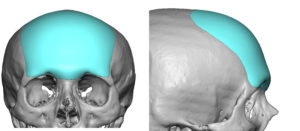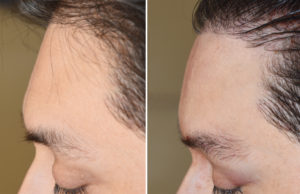Background: The upper third of the face has well known gender differences. The shape of the male forehead is distinctly different than that of a female. It is usually wider and vertically longer than in women, there is a slight backward slope to it as it ascends into the hairline and there is the presence of brow bone protrusions with a suprabrow break before heading upwards into the forehead.
Studies have shown that the angle of the curvature of the forehead is higher in women than in men which supports that the rounder forehead in the female and the more backward slope of the forehead in males. The acceptable aesthetic degree of backward angulation in the male forehead is not precisely established but what matters on a practical basis is whether the person finds it acceptable or not. One factor that has a major influence on the appearance of the slope of the male forehead is the vertical skin length. The further the hairline sits back, or even its complete absence, will affect how much of the forehead stands out.
Augmenting the male forehead is more challenging in men than women due to the frontal hairline location and the anterior scalp hair density. For most men the historic use of bone cements is often not practical since these require an almost full coronal scalp incision for proper placement and contouring. The best method today is the use of custom forehead implants made from the patient’s 3D CT scan. This allows their placement through a much smaller scalp incision and assure the smoothest forehead contour and desired shape due to preoperative designing.



Highlights:
1) A excessively backward sloping forehead is not an aesthetically desirable male forehead shape.
2) Forehead augmentation can be done while leaving the brow bone areas alone.
3) A custom forehead implant can be placed through a relatively small scalp incision.
Dr. Barry Eppley
Indianapolis, Indiana


